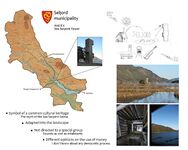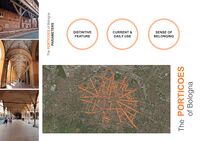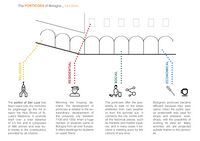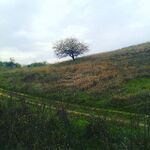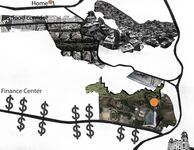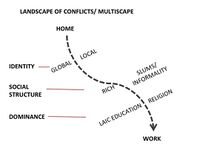LED Seminar 2016 - Landscape Symbols Reflection Group F
Landscape Symbol 1- Seljord Norway, Tora Grøstad
Representations and analytical drawings
in addition to your initial visual please add two further analytical drawings of your symbol
- GroupI slide2.JPG
Slide 2
- GroupI slide3.JPG
slide 3
Reflections
Seljord(in Norway) holds a lot of cultural engagement based on old traditions. As it is surrounded by mountains on all sides, many artists found earl interest in all the different perspectives, and some even settled down. Also musicians got inspired, and the melodies from the "Harding-fiddle" renders tones from old oral stories, oft accompanied by folk dance. Seljord also have long traditions within agriculture, and the annual Dyrsku-festival houses uptil 60.000 visitors a year. In later times different art projects have enlightened the many qualities in Seljord, and even a 17 meter high tower is built, counting as the main tourist attraction commercialising the myth of Selma the sea serpent. Since the main transport road between west end east passes seljord is it always a conflict between commercial businesses and conservation of cultural heritage.
The serpent tower, Sjøormtårnet, in Seljord was finished and available for visitors 18th of October 2011. It rises 17meter above the ground, but its wooden construction let it adapt to the landscape. It is situated by the lake of Seljord and is meant as a viewing point for discovering the well-known sea serpent, Selma. At night the construction allows light to emit and the tower appears as a luminous periscope in the horizontal landscape.
The tower itself is quite new, but the myth of the sea serpent is old. In 250 years, and probably even longer, have people claimed to have seen a large, serpent-like creature in the lake of Seljord. The stair tower can be seen as a symbol of the municipality’s many mysterious myths and cultural heritage. The tower is of course also meant to attract visitors to the small village, and the politicians together with the municipality have invested a lot of money with conscious motives of making an attractive place. As the tower just exist for 5 years it is difficult to say something about a potential change of meaning due to changes in the local society, but I think the tower can contribute to many different application, not only as a mean for seeing the sea serpent. For some locals, might the tower even become a personal spot, a free space where thoughts are allowed to drift freely through the landscape. The tower takes also part of a larger art project initiated in Seljord called Into the Landscape. As the municipality have a lot of cultural heritage and long traditions within art, it might have been initiated based on availability of money, or just the idea of promoting the village with a startling symbol.
Today the stair tower count as Seljord’s new landmark. It has been invested a lot of money on it, and many locals criticize the use of resources. On the other hand has the project gained international attention, and will hopefully drag visitors to Seljord, strengthening its reputation.
As the tower was built to enlighten old myths and traditions in Seljord, it has a strong foundation in the local society, but as an architectural, modern tower, it holds no specific cultural group. As it takes part of the art scene, there are of course many artists interested in the project, but the aim is to reach as many as possible. If we talk about different religions or people with different cultural heritage, I think there is a broad stage and shared understanding of the mystery, and the tower itself doesn’t make any difference, and can be used by anyone, whether the purpose is to see the sea serpent or not.
Landscape Symbol 2- Bologna, Federica Fulgini
Representations and analytical drawings
in addition to your initial visual please add two further analytical drawings of your symbol
- GroupI slide3.JPG
slide 3
Reflections
Please write a 250 words text reflecting on the following questions, you can also take ideas from your group members into account
- How and why did the symbols you identify appear in your landscape?
- Did their meaning change along with socio-political, economic, environmental or cultural changes in your region, or country?
- What do these symbols mean to you today? Are they meaningful to more than just one cultural group? Are they shared across cultures?
add your text here
Landscape Symbol 3- Place near to my home, Eszter Tóth
Representations and analytical drawings
in addition to your initial visual please add two further analytical drawings of your symbol
- GroupI slide2.JPG
slide 2
- GroupI slide3.JPG
slide 3
Reflections
Please write a 250 words text reflecting on the following questions, you can also take ideas from your group members into account
- How and why did the symbols you identify appear in your landscape?
- Did their meaning change along with socio-political, economic, environmental or cultural changes in your region, or country?
- What do these symbols mean to you today? Are they meaningful to more than just one cultural group? Are they shared across cultures?
add your text here
Landscape Symbol 4- Tegucigalpa, Mario Matamoros
Representations and analytical drawings
in addition to your initial visual please add two further analytical drawings of your symbol
- GroupI slide3.JPG
slide 3
Reflections
Please write a 250 words text reflecting on the following questions, you can also take ideas from your group members into account
- How and why did the symbols you identify appear in your landscape?
- Did their meaning change along with socio-political, economic, environmental or cultural changes in your region, or country?
- What do these symbols mean to you today? Are they meaningful to more than just one cultural group? Are they shared across cultures?
'This is my daily landscape perception as I commute from my house to my working place at the National University of Tegucigalpa. The image could be perceived as a conflict of landmarks rather than a clear lecture of symbols. The part of Tegucigalpa I live in is an former extension of the city, Tegucigalpa grew along its boulevards that originated from the historic downtown. The boulevards became then the new centers of business and economics. One of them, the Blvd Morazan became a fast food catalogue where I often buy a coffee to go or have a quick lunch. As I cross the boulevard I experience the clash of different social classes though a narrow street that has the rich and prominent at the left and the slums at the right. As I approach my workplace I cross the only Sport park of the city, which is sadly covered by a endless wall. and then I have two options of getting to my job; one evidences a control dispute between the catholics and the laic institutions, the university's expensive administrative building; the second crosses the back of the sport park and there you see a vast dry forest area that has everything to become a leisure park but remains unseen.
Landscape Symbol 5- Ibrahim Al Mardini
Representations and analytical drawings
in addition to your initial visual please add two further analytical drawings of your symbol
- GroupI slide2.JPG
slide 2
- GroupI slide3.JPG
slide 3
Reflections
Please write a 250 words text reflecting on the following questions, you can also take ideas from your group members into account
- How and why did the symbols you identify appear in your landscape?
- Did their meaning change along with socio-political, economic, environmental or cultural changes in your region, or country?
- What do these symbols mean to you today? Are they meaningful to more than just one cultural group? Are they shared across cultures?
add your text here
Group reflection
Please add a summary of your group reflection here
